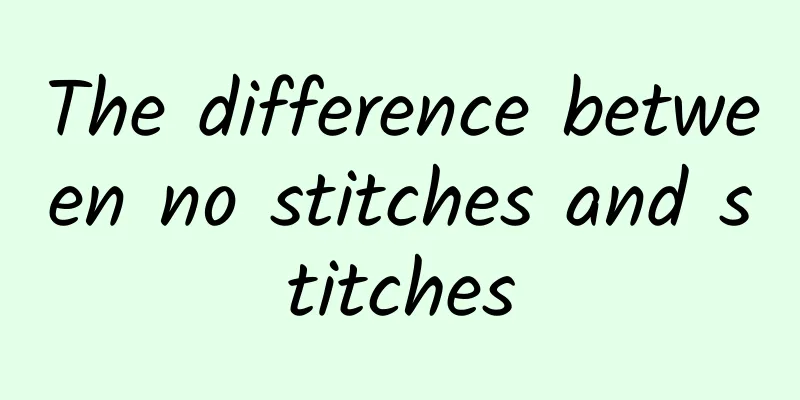The difference between no stitches and stitches

|
Physical injuries are very common in life, and we need to judge whether stitches are needed based on the severity of the wound. Suturing wounds helps promote healing, but if the wound does not need to be sutured, it would be a wasted trip to the hospital. The key is to understand the difference between not suturing and suturing, that is, to determine whether the wound needs to be sutured. Let’s take a closer look below. Stopping the bleeding as quickly as possible is of utmost importance. Apply pressure to the wound with a clean cloth or damp tissue and wait five minutes to see if the bleeding continues. If the bleeding is out of control, do not try any of the following methods and go to the hospital immediately for stitches. If the bleeding stops, please continue reading. Carefully analyze the severity of the wound: 1. Is the wound a stab wound? Puncture wounds usually penetrate deep into the skin, and the object that punctures the skin may be pulled out or remain in the skin. This object has a special name, called a "piercing object." Puncture wounds are usually hole-like, rather than strip-like like scratch wounds. 2. Is the wound a cut? Cuts and puncture wounds are similar in that they break the surface of the skin, but they differ significantly in length and depth. A cut is what we often call an incision. 3. Is the wound a postoperative wound dehiscence? A surgical wound is similar to a cut in that it is caused by a scalpel breaking the skin, but the edges of a surgical wound are not rough like a cut; they are very smooth. 4. Is the wound a laceration? A laceration is a tear or lift of a large area of skin. 5. Is the wound an abrasion? An abrasion is a scratch, nick, or small cut that goes beneath the surface of the skin. However, whether a wound requires sutures is determined by its depth. If the cut is deep, then the wound should be called a cut or a laceration, depending on its shape. After understanding the type of wound, you can determine whether it needs suturing. There are three ways to judge: 1. Observe the depth of the wound. Is yellow fatty tissue visible at the wound site? Is the skeleton exposed? Is there a large area of flesh exposed under the skin? Is the wound deeper than 6 mm? If any of the above situations apply, you will need stitches. 2. Observe the width of the wound. Can the wound be pinched closed? Usually the function of bandages and gauze is to close the wound. After the wound is closed, a scab will form and it will begin to heal itself after 12 hours. However, if the wound is too wide to be closed with a bandage, you will need stitches to force the skin closed to help it heal. 3. Observe the location of the wound. If the wound is located in a part of the body that moves frequently, it is best to go to the hospital for stitches to prevent the wound from expanding or tearing again due to movement. For example, wounds on the legs and fingers (especially at the joints) may require stitches, whereas wounds on the forehead generally do not. However, if the wound is particularly deep or wide, you should go to the hospital for stitches immediately, regardless of whether it is located in a frequently active area. Remember, the depth and width of the wound play a decisive role in determining whether sutures are needed. There are also some situations that require immediate medical attention, such as: 1. Animal bites or human bites. 2. There are residues in the wound that cannot be removed. This also applies to puncture wounds where the object must be removed medically. 3. The wound cannot stop bleeding. If this happens, call an ambulance immediately. 4. The injured person suffers from diabetes. 5. The wound edges cannot close. |
<<: The benefits and harms of betel nut
Recommend
What causes bitter taste in mouth?
There are many reasons for a bitter mouth. Genera...
Can Tripterygium wilfordii glycosides tablets treat kidney disease?
Most people may not be very familiar with membran...
Post-herpetic syndrome
There are many common diseases. The treatment met...
Stinging of the skin around the eyes
In daily life, eye cream is a very common eye ski...
Effects and contraindications of Wanhua Oil
Kevlar is a common medicine in our lives. When we...
What medicine is used for children's skin itching
It is actually very common for children to have i...
How to treat uterine displacement
Uterine displacement is also a relatively common ...
How long does it take to recover after parotid gland tumor surgery?
Parotid gland tumor is a tumor that has no obviou...
Can I drink coffee if I have gastritis?
Nowadays, food is becoming more and more diverse,...
What to do if you have frequent urination due to cold
Frequent urination is an abnormal physiological p...
Why is there yellow fluid coming out of my chest?
The situation of yellow water coming out of the c...
The best treatment for lumbar disc herniation
Everyone's waist is relatively important, but...
Does heat in the palms indicate kidney yin deficiency?
It is common to feel hot palms in daily life. Fro...
How to regulate Qi and Yin deficiency? Chinese medicine recommends dietary regulation
Qi deficiency and Yin deficiency are both terms i...
What is the best way to wash your face when it itches?
Itchy face is most likely caused by skin allergie...









